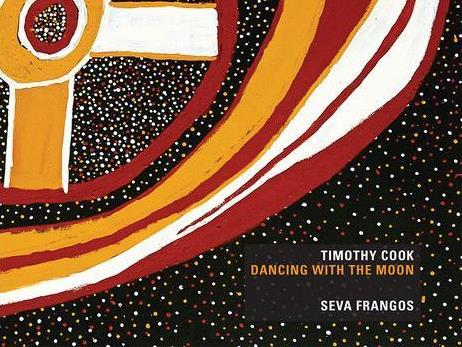Timothy Cook: Dancing with the Moon by Seva Frangos and published by UWA Publishing is a sensitive and thorough examination of an exemplary artists oeuvre. This well-produced monograph covers Cook’s first forays into painting in the late 1990’s through to the present day. It was published in conjunction with a solo exhibition (of the same name) at Seva Frangos Art with his most recent works.
Spanning nearly 20 years, Cook’s career has seen him involved in some of the most exciting exhibitions, awards and collections. Recently his career culminated with Cook being awarded the winner of the 29th NATSIAA (National Aboriginal and Torres Strait Islander Art Awards) in Darwin, the first Tiwi artist to do so.
His work, which boldly straddles past and present, Christian faith and Tiwi traditional culture, the corporeal and the heavenly, has cemented him as an artist of high importance, not just amongst Tiwi or Aboriginal artists but within the canon of Australian art history as a whole.
Over 140 plates of Cook’s mesmerising works are included. They are heavily influenced by the two most important Tiwi ceremonies, that of the Kulama and Pukamani: mythological stories relating to the creation of the land and of the Tiwi people and their culture.
The wide variety of plates are accompanied by several essays that outline the details of Cook’s personal history, his relationship to his surrounds, his faith and his culture. For those who are not familiar with Tiwi culture, most of the essays cover (if briefly) how the traditional ceremonies and stories of the Kulama and Pukamani have influenced Cook’s jilamara (designs).
Frangos has carefully selected the contributors, choosing those curators and art historians who have followed Cook’s work intimately or those who have worked with him personally over a number of years. These include Judith Ryan, Bruce McLean, Glenn Isegar-Pilkington, and Quentin Sprague.
Because of their intimate knowledge of Cook and his art, these authors are able to give the reader an in-depth contextualisation for Cook’s work. The essays are also cleverly set out in a way that examines Cook’s work layer by layer, delving first into an analysis of the man and artist himself, then the influences from Tiwi culture and the importance of ‘country’ or place, through to Cook’s position as an artist in both Tiwi and a broader Australian art dialogue. It ends with a highly detailed chronological analysis by Judith Ryan.
Perhaps the most important essay, however, is one by Quentin Sprague. Though Cook’s works are deeply embedded in Tiwi culture, Sprague argues convincingly that Cook’s work must also be seen as embodying influence from cultures other than his own, along with his own personal aesthetic innovations and concerns.
The plates themselves are numerous, and are divided throughout the book into various stylistic categories that (generally) encompass certain years over Cook’s practice. While the book gives an excellent full-bodied view of his oeuvre, it is a shame some of the plates and other images are of poor or grainy quality, which doesn’t allow the viewer to properly consider or appreciate each individual work.
This book is certainly a must for those who love Cook’s work, and for those who appreciate contemporary Tiwi, Islander or Aboriginal art. Apart from allowing for a greater appreciation of the complexity that influences and directs Cook’s work, it hopefully paves the way for further detailed art historical analysis of individual artists who sit in a similar position to Timothy Cook.
Rating: 4 stars out of 5
Timothy Cook: Dancing with the Moon
Seva Frangos
Paperback
184 Pages
RRP $49.99
UWA Publishing





